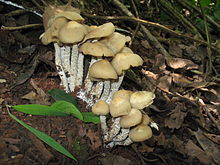Toxic mushrooms
Many mushroom species produce secondary metabolites that can be toxic, mind-altering, antibiotic, antiviral, or bioluminescent. Although there are only a small number of deadly species, several others can cause particularly severe and unpleasant symptoms. Toxicity likely plays a role in protecting the function of the basidiocarp: the mycelium has expended considerable energy and protoplasmic material to develop a structure to efficiently distribute its spores. One defense against consumption and premature destruction is the evolution of chemicals that render the mushroom inedible, either causing the consumer to vomit the meal (see emetics), or to learn to avoid consumption altogether. In addition, due to the propensity of mushrooms to absorb heavy metals, including those that are radioactive, European mushrooms may, to date, include toxicity from the 1986 Chernobyl disaster and continue to be studied.[31][32]
Psychoactive mushrooms
Mushrooms with psychoactive properties have long played a role in various native medicine traditions in cultures all around the world. They have been used as sacrament in rituals aimed at mental and physical healing, and to facilitate visionary states. One such ritual is the velada ceremony. A practitioner of traditional mushroom use is the shaman or curandera (priest-healer).[33]
Psilocybin mushrooms possess psychedelic properties. Commonly known as "magic mushrooms" or "'shrooms", they are openly available in smart shops in many parts of the world, or on the black market in those countries that have outlawed their sale. Psilocybin mushrooms have been reported as facilitating profound and life-changing insights often described as mystical experiences. Recent scientific work has supported these claims, as well as the long-lasting effects of such induced spiritual experiences.[34]
Psilocybin, a naturally occurring chemical in certain psychedelic mushrooms such as Psilocybe cubensis, is being studied for its ability to help people suffering from psychological disorders, such as obsessive–compulsive disorder. Minute amounts have been reported to stop cluster and migraine headaches.[35] A double-blind study, done by the Johns Hopkins Hospital, showed psychedelic mushrooms could provide people an experience with substantial personal meaning and spiritual significance. In the study, one third of the subjects reported ingestion of psychedelic mushrooms was the single most spiritually significant event of their lives. Over two-thirds reported it among their five most meaningful and spiritually significant events. On the other hand, one-third of the subjects reported extreme anxiety. However, the anxiety went away after a short period of time.[36] Psilocybin mushrooms have also shown to be successful in treating addiction, specifically with alcohol and cigarettes.[37]
A few species in the Amanita genus, most recognizably A. muscaria, but also A. pantherina, among others, contain the psychoactive compound muscimol. The muscimol-containing chemotaxonomic group of Amanitas contains no amatoxins or phallotoxins, and as such are not hepatoxic, though if not properly cured will be non-lethally neurotoxic due to the presence of ibotenic acid. The Amanita intoxication is similar to Z-drugs in that it includes CNS depressant and sedative-hypnotic effects, but also dissociation and delirium in high doses.
Medicinal properties
Main article: Medicinal mushrooms
Some mushrooms or extracts are used or studied as possible treatments for diseases, including polysaccharides, glycoproteins and proteoglycans.[38] Currently, several extracts have widespread use in Japan, Korea and China, as adjuncts to radiation treatments and chemotherapy,[39][40] even though clinical evidence of efficacy in humans has not been confirmed.
Historically, mushrooms have been thought to hold medicinal value in traditional Chinese medicine.[41] They have been studied in modern medical research since the 1960s, where most studies use extracts, rather than whole mushrooms.
In some countries, extracts of polysaccharide-K, schizophyllan, polysaccharide peptide, or lentinan are government-registered adjuvant cancer therapies.[39][42]
Other uses
Mushrooms can be used for dyeing wool and other natural fibers. The chromophores of mushroom dyes are organic compounds and produce strong and vivid colors, and all colors of the spectrum can be achieved with mushroom dyes. Before the invention of synthetic dyes, mushrooms were the source of many textile dyes.[43]
Some fungi, types of polypores loosely called mushrooms, have been used as fire starters (known as tinder fungi).
Mushrooms and other fungi play a role in the development of new biological remediation techniques (e.g., using mycorrhizae to spur plant growth) and filtration technologies (e.g. using fungi to lower bacterial levels in contaminated water).[44]






No comments:
Post a Comment